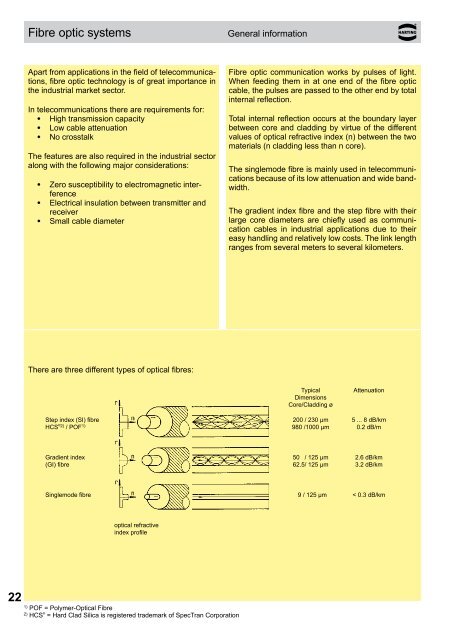Download - Harting
Download - Harting
Download - Harting
Create successful ePaper yourself
Turn your PDF publications into a flip-book with our unique Google optimized e-Paper software.
Fibre optic systems<br />
General information<br />
Apart from applications in the field of telecommunications,<br />
fibre optic technology is of great importance in<br />
the industrial market sector.<br />
In telecommunications there are requirements for:<br />
• High transmission capacity<br />
• Low cable attenuation<br />
• No crosstalk<br />
The features are also required in the industrial sector<br />
along with the following major considerations:<br />
• Zero susceptibility to electromagnetic inter -<br />
ference<br />
• Electrical insulation between transmitter and<br />
receiver<br />
• Small cable diameter<br />
Fibre optic communication works by pulses of light.<br />
When feeding them in at one end of the fibre optic<br />
cable, the pulses are passed to the other end by total<br />
internal reflection.<br />
Total internal reflection occurs at the boundary layer<br />
between core and cladding by virtue of the different<br />
values of optical refractive index (n) between the two<br />
materials (n cladding less than n core).<br />
The singlemode fibre is mainly used in telecommunications<br />
because of its low attenuation and wide bandwidth.<br />
The gradient index fibre and the step fibre with their<br />
large core diameters are chiefly used as communication<br />
cables in industrial applications due to their<br />
easy handling and relatively low costs. The link length<br />
ranges from several meters to several kilometers.<br />
There are three different types of optical fibres:<br />
Typical<br />
Dimensions<br />
Core/Cladding ø<br />
Attenuation<br />
Step index (SI) fibre 200,/ 230 µm 5 ... 8 dB/km<br />
HCS ® 2)<br />
/ POF 1) 980,/1000 µm 0.2 dB/m<br />
Gradient index 50,5/ 125 µm 2.6 dB/km<br />
(GI) fibre 62.5/ 125 µm 3.2 dB/km<br />
Singlemode fibre 9,/ 125 µm < 0.3 dB/km<br />
optical refractive<br />
index profile<br />
22<br />
1)<br />
POF = Polymer-Optical Fibre<br />
2)<br />
HCS ® = Hard Clad Silica is registered trademark of SpecTran Corporation





